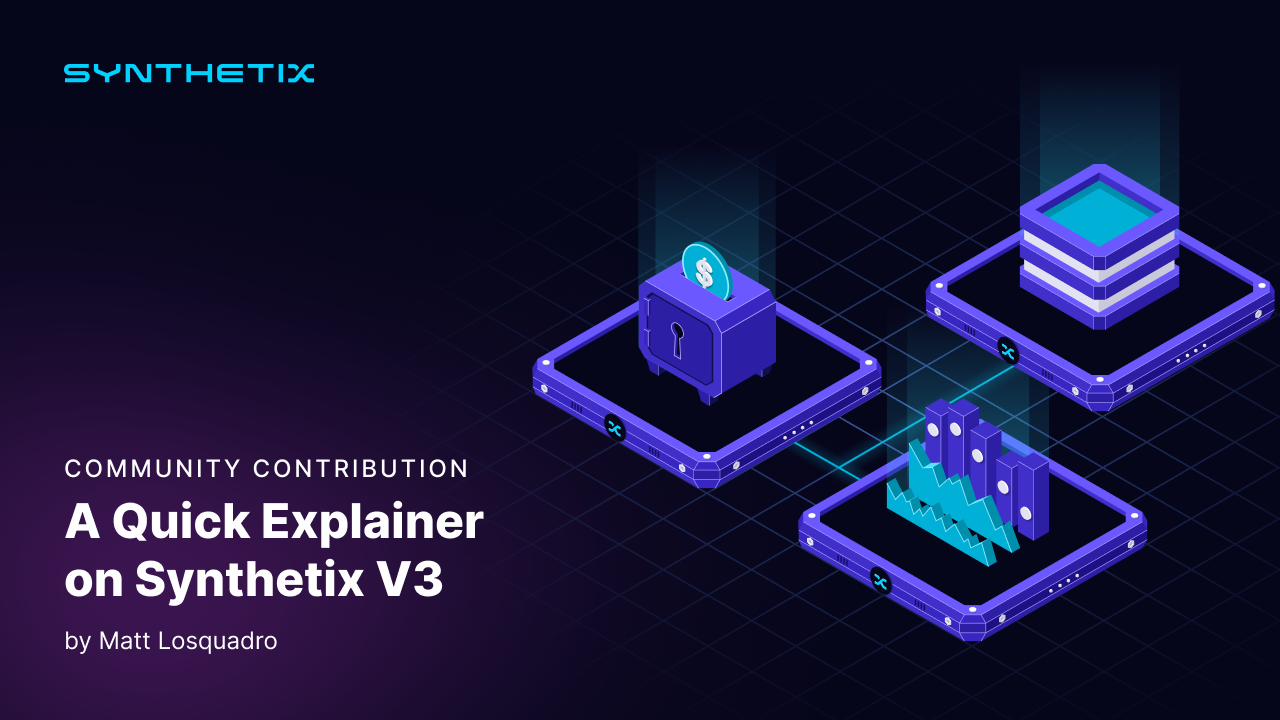A quick explainer on Synthetix V3
Synthetix stands at the cusp of creating a DeFi revolution with its upcoming V3 release. It'll help to usher in a period of mass innovation throughout the world of onchain derivatives and financial instruments.

TL;DR: Synthetix is set to revolutionize DeFi with its V3 release, enabling users to pool collateral, create onchain financial markets, and power countless new protocols with Synthetix liquidity and infrastructure. In essence, V3 offers a more dynamic and modular approach to onchain derivative creation, liquidity growth, and infrastructure management, expanding the possibilities of what can be built atop the protocol.
Synthetix stands at the cusp of creating a DeFi revolution with its upcoming V3 release. It'll help to usher in a period of mass innovation throughout the world of onchain derivatives and financial instruments.
What is Synthetix V3? Let me explain.
At its core, the entire Synthetix V3 system is a Collateralized Debt Position (CDP) protocol. Similar to MakerDAO/Liquity, you take your collateral (SNX, ETH/wsteth/other LSDs/etc), deposit it into a contract, and then generate a stablecoin. In Synthetix's case, the system-generated stablecoin is sUSD.
The differentiator for Synthetix is that you can instead delegate your entire CDP, collateral and all, to a larger basket of collateral called a Pool.
Pools can be considered a collective CDP, with baskets of collateral used to generate sUSD and allocate liquidity to derivative markets for traders to utilize. Pool owners are the deciders of how liquidity is allocated. Because of this, even though anyone can create and manage a pool, most stakers will likely direct their collateral to more ‘trusted’ pools. For example, the Spartan Council Pool, whose owners are directly elected by SNX token holders.
Pools then use this collateral and allocate it to derivative Markets. Markets are arguably the most important piece of the entire protocol, as they're the logic that turns LP liquidity into onchain financial instruments. Well-designed markets hope to generate delta-neutral fees for LPs - which, in this case, means that the fees earned by liquidity providers are unaffected by perps trader profit and losses, ensuring stable returns regardless of volatility. A recent example of a 'well-designed market' is Synthetix Perps, which has returned $24m+ in fees to Synthetix Stakers. Synthetix Perps has built-in risk management designs like price-impact and dynamic funding rates, which work together to keep the market delta neutral.
LP's, Pools, Markets & Traders
Before we go any further, let's first quickly break down the flow of liquidity in the Synthetix V3 system.
Liquidity Provider --> Pools --> Markets --> Traders
This is the entire system in a nutshell, with LPs providing the initial collateral, then pools receiving this delegated collateral and using this collateral to generate sUSD and allocate it to markets. Markets deploy this sUSD to provide liquidity for markets like Synthetix Perps, and then traders utilize this liquidity for trading.
The flow of fees goes the opposite way
Traders --> Markets --> Pools --> Liquidity Providers
All pools within the Synthetix V3 system will distribute fees on a pro-rata basis, meaning that those who provide more collateral to the pool will receive more fees. There's one caveat here in that Pool Owners can create a rewards distributor. This distributor can siphon off a percentage of the generated fees, and distribute them to any address, collateral type, etc., in any way. Additionally, the rewards distributor can receive incentives from an outside source, and distribute these additional rewards to LPs, these can include token rewards, inflationary rewards, etc.
A rewards distributor, managed by the pool owner, could decide to allocate 10% of all fees to the original creator of the market, or 10% of all fees to SNX stakers. Alternatively, the rewards distributor can distribute additional rewards to LPs in the market - an example is inflationary SNX, which would be distributed through a rewards distributor. It's maximally configurable. To learn more about it, read about it in the official Synthetix V3 docs.
Before delving into markets, let's begin with a broad overview of the entire system. Below is a graphic of the Synthetix V3 system to visualize the structure.
I am sure you understand the illustration. Now, let's delve deeper into the markets.
Markets in Development & Potential Markets
Some additional markets being developed right now include Perps V3 & Spot, which will enable the creation of perpetual futures and spot synthetic assets. Markets are maximally configurable and modular. Developers can create a market for any derivative using any available onchain Oracle. Here's a non-exhaustive list of potential markets from Synthetix Core Contributor Cavalier's recent blog post on Synthetix V3:
- Perpetual Futures / Options / Structured Products: trading using synthetic assets to represent leveraged positions for perpetual futures, including basis trading, and funding rate arbitrage vaults. Example - GMX could be built on Synthetix v3.
- NFT-Fi borrowing/perpetuals: Users can borrow synthetic assets collateralized by NFTs or create perpetual contracts speculating on the future value of NFTs, with rewards distributed to Synthetix stakers. For instance, nftperp.xyz could be built on Synthetix v3
- Insurance markets: Users can purchase insurance contracts for various risks, collateralized by Pools and governed by smart contracts. Eg. Nexus Mutual could be built on Synthetix v3.
- Prediction markets / Binary Options / Sports Bettings: Users can trade shares based on the outcome of events, such as election results or sports games. Eg. Overtime Markets could be built on Synthetix v3.
- Games: any game could leverage Synthetix collateral, to provide competitive prizes. Eg. a lottery (or no-loss lottery, like PoolTogether) is easy to implement on Synthetix v3.
- Offchain / RWA Markets: Markets could be developed for real-world assets such as art, carbon credits or other offchain assets or instruments. With sufficient oracles and trusted entity verification, this "trust" could generate capital on chain, backed by Synthetix and snxUSD.
The opportunities are endless. Now, while these market possibilities are intriguing, the key component powering these derivatives is liquidity. Let's delve into how Synthetix V3 addresses the challenge of onchain liquidity.
Liquidity as a Service or LAAS
Building onchain derivatives is HARD. Many protocols have tried, and many protocols have died.
The biggest problem plaguing derivative protocols is commonly referred to as the chicken and egg problem. New derivative protocols can't onboard traders because they have no liquidity, and they can't bring in liquidity because they don’t have traders. It doesn't matter how novel or bespoke your protocol is; if you have no liquidity, you're dead in the water, and that's that.
That's where Synthetix comes in. Liquidity as a service.
Developers build on Synthetix infrastructure and then convince LPs to deposit collateral into pools to funnel liquidity to their derivative markets. Instead of having to reinvent the wheel, you'll instead be within the Synthetix ecosystem, a protocol with a history of supporting innovative ideas and new protocols.
I imagine most protocols will use a mixture of old-school liquidity growth through token brrr and ask the Spartan Council for an initial seed of liquidity to get them off the ground. This is the benefit of the Synthetix system - you can gather liquidity yourself and work through governance to gather liquidity for your new idea. But Synthetix doesn’t just stop at providing liquidity. It offers a solution to developers by managing backend infrastructure complexities as well.
Infrastructure as a service
Developers don't need to manage infrastructure specific to liquidity provisioning, leaving them to focus on the two most important parts of their protocols - derivative mechanism design, and a proper frontend to help onboard and educate traders.
Just imagine the countless hours developers across DeFi have spent building infrastructure that could've been spent on creating a better product. Synthetix V3 will soon abstract all of that pain away.
Synthetix V3 handles everything, and you don't need to rebuild liquidity management, and reward distributors, for each and every market you build.
Go Deeper
Here’s a non-exhaustive list of other resources for learning more about Synthetix V3:
- Synthetix V3 Docs
- Synthetix V3 FAQ
- Synthetix V3 Development Progress
- Where Synthetix V3 could take us - CC Cavalier
- Getting to the Synthetix v3 End Game - CC Cavalier
- $500m is waiting for you to #BuildOnSynthetix - CC Cavalier
- Synthetix V3 is on Mainnet - CC Noah
- Perps V3 Testnet Competition
- “A New hope” - Kain Warwick

